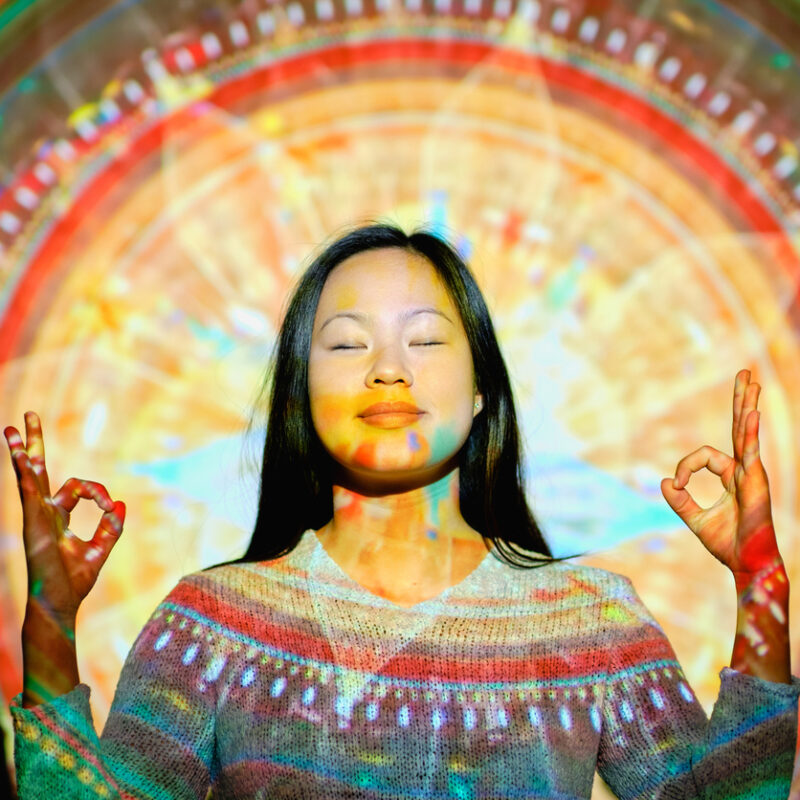Have you ever entered a room and felt like there was tension in the air? Or, on the contrary, was the atmosphere pleasant?
If so, you’ve interacted with subtle energy—and directly experienced the science of intention. Similarly, an increasing amount of people have felt the positive effects of energy healing. Science has yet to describe its underlying mechanisms and the nature of intention and subtle energy, which seems to exist outside of the known physical laws.
That being said, thousands of studies have pointed to the benefits of energy healing. There seems to be a sort of mind-matter interaction going on that allows the invisible energy to affect something as physical as the human body.
What is distant energy healing?
Distant or remote energy healing is the phenomenon by which a healer is sending energy from a distance. The distance doesn’t matter: the healer can be on the other side of the earth from the receiver.
While it can make sense that energy healing works in person, it can be harder to wrap your mind around distant energy healing—if we don’t accept that invisible, mystical force that lives outside of the ordinary world of physics. If we do accept it, remote healing is as normal as psi phenomena like telepathy or premonition.
What is the science of intention?
The science of intention aims to describe the mechanisms by which energy healing can be performed at a distance. Contrary to what many people may think, this intriguing phenomenon has been studied scientifically with astounding results.
In a 2015 paper, Distant Healing Intention Therapies: An Overview of the Scientific Evidence, IONS’ Radin & co review some of these studies. The studies have in common that they explore the effects of what’s called Distant Healing Intention (DHI). DHI is the ability of one person’s focused intention to affect another person or system at a distance.
So, what did they find out? These studies provide evidence that DHI can have a measurable effect on physiological states and behaviors. While the effects are generally small, they have been consistently replicated across multiple independent laboratories.
Despite these promising results, the clinical efficacy of DHI remains controversial. Some studies that showed a favorable outcome are accompanied by methodological flaws that make the validity of the results questionable.
The role of quantum physics
A theory about the science of intention is that it works through quantum physics. DHI challenges classical notions of space and time, suggesting that healing intentions might operate through mechanisms similar to quantum entanglement, where particles influence each other instantaneously over distances. This theoretical framework offers a possible explanation for how energy healing could work not just locally but also affect someone far away.
Challenges of studying the science of intention
One could argue that the placebo effect can interfere with healing intention, making it challenging to distinguish its objectivity: do energy healing or positive intentions sent to a person work because the recipient expects them to? Or do they have a positive effect regardless?
To answer that question, the scientists reviewed studies involving simpler life forms, such as plants, cells, and animals. These experiments have demonstrated statistically significant effects of DHI, such as changes in the growth rates of bacteria and the recovery rates of animals from various conditions. However, the quality of these studies is often low, making it difficult to draw definitive conclusions.
An area like the science of intention inevitably faces epistemological challenges. Traditional research methodologies may be inadequate for capturing the complex, potentially non-linear effects of DHI. More innovative study designs that account for the nonlocal nature of DHI might be needed, and measures need to be taken to reduce bias.
Can healing intentions affect the shape of ice crystals?
In the IONS article Three Remarkable Studies on the Science of Intention, we learn about how intention can affect ice at a distance. You might have heard about Masaru Emoto’s photo project, in which ice crystals responded differently to positive vs. negative intentions. The crystals subjected to positive intentions took on a harmonious, symmetrical shape, while those that received negative intentions looked irregular and fractured.
However, the project was not a scientific study. That’s why, intrigued by these findings, Dean Radin from IONS decided to investigate whether these results could be replicated in a scientific setting—in collaboration with Emoto, Gail Hayssen, and Takashige Kizu. A positive result would support the science of intention.
This double-blind study was conducted in 2006 in the following way:
An audience of about 2,000 people, led by Emoto in Japan, focused their intention on water samples. These samples were placed in an electromagnetically shielded chamber in the IONS lab in California. Also, unbeknownst to Emoto and the Japanese research participants, water samples from the same source were set aside in a different location at IONS. These additional samples were used as a control.
In the next step, the water was sent to Emoto’s lab in Japan without labeling which samples were treated. The water was frozen into ice crystals. An independent panel of 100 participants then judged photos of these ice crystals by their aesthetic appeal.
The results showed that ice crystals from the water subjected to positive intentions were judged as significantly more beautiful than the crystals in the control. The odds against chance are a thousand to one. So, the experiment supports Emoto’s original photo study.
Unveiling the mechanisms behind intention
Imagine a world where we can send healing frequencies to someone across the globe as easily as we send a text message today! The success of future studies will determine whether this scenario will be considered Harry Potter or normal life.
More robust experiments are needed to unveil the mechanisms behind intention. If we understand them better, they could revolutionize areas like health care, communication, and well-being.
